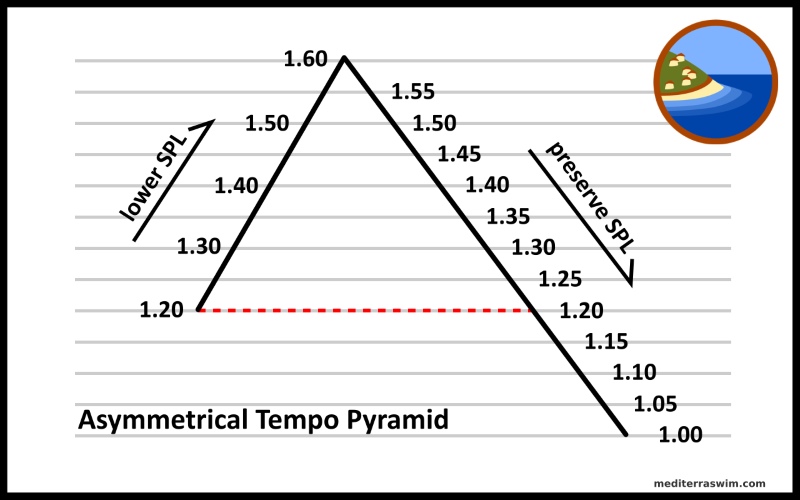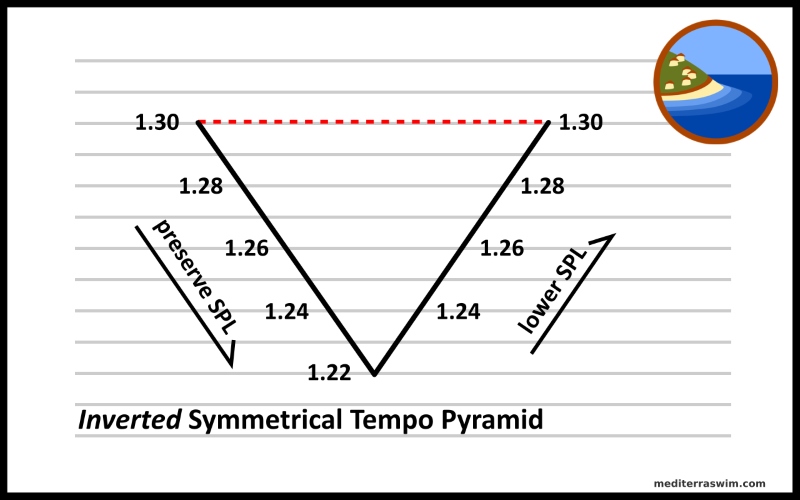by Admin Mediterra | Sep 27, 2020 | Practice Design, Tempo
A tempo pyramid is a special kind of practice set, using a Tempo Trainer and timing the stroke movement to coincide with the BEEP on the Tempo Trainer.
A Tempo Pyramid set is intended to help your brain discover ways to lengthen the stroke without slowing your speed to do it.
You will start with an assigned tempo (TS), or you may choose one near the middle of your comfortable tempo (TC) range. You count strokes on every length.
There will be a series of repeats, usually like 2x 25 or 2x 50. At each new step in the series you will change the tempo on the Tempo Trainer by the amount indicated in the practice instructions.
It is called a ‘pyramid’ because of the way we might graph the changes in tempo, during the set.

In this example above, the swimmer starts with tempo 1.20 and swims 2x 25. On each next step she slows the tempo by +0.10 seconds and swims another 2x 25. She repeats this process for 5 steps, until arriving at tempo 1.60. On the way ‘up’ she is looking for ways to lengthen her stroke since she a little more more time per stroke on each next step. She wants to reduce her stroke count (SPL).
Then she begins working her way back down, swimming 2x 25 on each step, by increasing the tempo by -0.05 seconds on each step. These are half-steps (0.05 is half of 0.10 seconds), and this gives her brain more time to adapt as tempo increases. On the way ‘down’ she is looking to preserve as much of that longer stroke (lower stroke count, or lower SPL) even through tempo is gradually increasing.
The pyramid could be normal upright’, like this example above, where tempo is first slowing down, then speeding up. Or it could be inverted’ where tempo is first speeding up, then slowing back down.

The pyramid could be ‘symmetrical’ where the changes in tempo are the same on both sides. Or it could be ‘asymmetrical’ where the tempo changes half-as-much per step, on the second half (as shown in the first diagram).
The main point of tempo pyramids is to trick the body and brain into discovering ways to lengthen and protect stroke length even though tempo is changing. The key to these sets is concentration on precise body position and movements, while relaxing all other parts of the body more deeply.
by Admin Mediterra | Sep 27, 2020 | Master Class Instructions
Outline
This is the general outline for your Tempo Practice:
- Tune-Up (a.k.a. warm-up) – your choice
- Main Set 1
- Main Set 2
- Review (a.k.a. cool-down, or wrap-up) – your choice
The distance and complexity of these tempo sets are designed according to the stage. You will find those sets listed for each practice plan.
To begin you will need to experiment (if you don’t already know) to find a tempo that feels quite natural to you already. This would be a tempo that is comfortable to hold for as long as you can swim right now. We will call this TC (for Tempo – Comfortable).
Purpose
- To increase precision of movements during breathing.
- To improve the consistent timed rhythm of those movements.
Distance
The main sets will total about 500 to 2000 meters.
Intensity
Work around RPE 3 to 4, with the expectation that improvement in control over breathing will lower your sense of effort from RPE 4 to 3.
Complexity
The challenge level (the neurological complexity) is determined by the focal points you choose and the standard for quality you set for each of those focal points, and the tempo at which you try to perform.
For Level 1 swimmers you may keep the tempo at TC for the entire course – though I anticipate you will feel like increasing it slightly within a few weeks, as your breathing gets better. You are free to keep it the same or increase slightly, according to the prescriptions in the practices.
For Level 2 swimmers I will recommend tempo increases at each stage (or per week). In the first week you will keep you tempo at TC. The tempo will increase in certain increments, no more than -0.02 steps at a time.
I will give those recommendations, but again, you will need to adjust a little more or a little less to suit your individual needs.
Success Is… (a.k.a. Measurements)
Your quantity objective is to hold the assigned tempos for each set. Your quality objective is to successfully achieve your focal point goal 60-90% of the drill or interval at 2 or 3 Star performance (see Simple Rating System for Your Practice Results article above for definition of Quality Star Rating).
Failure Points
When you notice yourself failing to achieve your objective for the task that is the trigger for you to find the possible cause so you can make adjustments in your focal point or adjustment in your task complexity. If you are failing to meet your standard for more than 50% of the time you may add more rest, or lower the tempo slightly (by .01 or .02 seconds).


